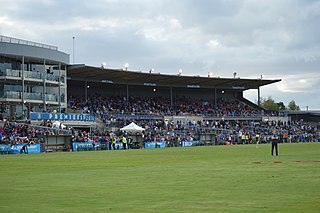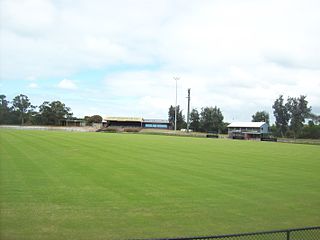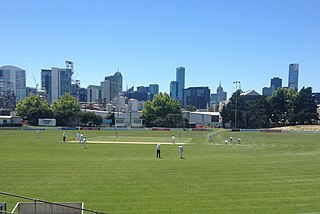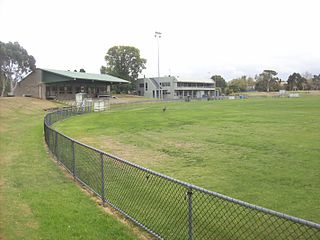
Williamstown is a suburb in Melbourne, Victoria, Australia, 11 km (6.8 mi) south-west of Melbourne's Central Business District, located within the City of Hobsons Bay local government area. Williamstown recorded a population of 14,407 at the 2021 census.

Windy Hill is an Australian rules football and cricket ground located in Napier Street, Essendon, a northwestern suburb of the Melbourne metropolitan area.

Whitten Oval is a stadium in the inner-western suburbs of Melbourne, Victoria, Australia, located in Barkly Street, West Footscray. It is the training and administrative headquarters of the Western Bulldogs, which competes in the Australian Football League (AFL). The ground is also the home of the club's women's and reserves teams which compete in the AFL Women's (AFLW), Victorian Football League (VFL), and VFL Women's (VFLW).

The Williamstown Football Club, nicknamed the Seagulls, is an Australian rules football club based in Melbourne. The club currently competes in the men's Victorian Football League and VFL Women's competitions.

Trevor Barker Beach Oval, currently known under naming rights as the Wilson Storage Trevor Barker Beach Oval, is an Australian rules football ground in Beach Road, on the border between Hampton and Sandringham, Victoria. Most commonly known as Beach Road Oval throughout its existence, in 1998 the ground was renamed after the late Trevor Barker, who died of cancer in 1996 at the age of 39. Barker had coached the Sandringham Football Club to the 1992 and 1994 premierships.

Arden Street Oval is a sports oval in North Melbourne, Victoria, Australia. It is currently the training base of the North Melbourne Football Club, an Australian rules football club, and up to the end of the 1985 season it was used as the team's home ground for Victorian Football League (VFL) matches.

The East Melbourne Cricket Ground was a grass oval sports venue located at the corner of Wellington Parade and Jolimont Parade, in East Melbourne, Victoria, Australia. Now part of Yarra Park and being adjacent to the Melbourne Cricket Ground, the site is best known for playing host to many sporting events during the city of Melbourne's early existence, consisting mainly of cricket and Australian rules football, although the ground occasionally hosted soccer matches.

Coburg City Oval is an Australian rules football and cricket stadium located in Coburg, Australia. It is home to the Coburg Football Club in the Victorian Football League, and the Coburg Cricket Club.
Princes Park is an Australian rules football ground located inside the Princes Park precinct in the inner Melbourne suburb of Carlton North. Officially the Carlton Recreation Ground, it is a historic venue, having been Carlton Football Club's VFL/AFL home ground from 1897.

North Port Oval, also known as the Port Melbourne Cricket Ground or by the sponsored name ETU Stadium, is an Australian rules football and cricket stadium located in Port Melbourne, Australia. The capacity of the venue is 6,000 people. It is home to both the Port Melbourne Cricket Club and the Port Melbourne Football Club.

The Yarraville Oval is an Australian rules football and cricket ground located on the corner of Williamstown Road and Anderson Street in Yarraville, Victoria. It is currently the home ground of the Yarraville/Seddon Eagles Football Club and the Yarraville Cricket Club.

The Preston City Oval is an Australian rules football stadium in Cramer Street in Preston, Victoria, a suburb of Melbourne. It has a main grandstand and the ground is capable of holding around 5,000 spectators.
The 1886 Victorian Football Association season was the 10th season of the Australian rules football competition. The premiership was won by the Geelong Football Club. It was the club's seventh VFA premiership, and the last won by its senior team.

The 1888 Victorian Football Association season was the 12th season of the Australian rules football competition.

Box Hill City Oval is an Australian rules football and cricket stadium located in Box Hill, Victoria, Australia. It is the home ground of the Box Hill Hawks Football Club which plays in the Victorian Football League, and the Box Hill Cricket Club which plays in the Victorian Sub-District Cricket Association.

Elsternwick Park is an Australian rules football and cricket stadium in Brighton, a suburb of Melbourne in Victoria, Australia. The name also refers to the wider parkland in which the main oval is located. The ground is the administrative and primary central playing base of the Victorian Amateur Football Association.

Chirnside Park is an Australian rules football ground in Werribee, Victoria, Australia, located between Watton Street and the Werribee River.

The 1908 Victorian Football Association season was the 32nd season of the Australian rules football competition. The premiership was won by the Footscray Football Club, after it defeated Brunswick in the final by 24 points. It was the fourth premiership won by the club.
The 1942 Victorian Football Association season was not played owing to World War II, which was at its peak at the time.
The 1959 Victorian Football Association season was the 78th season of the Australian rules football competition. The premiership was won by the Williamstown Football Club after it defeated Coburg in the Grand Final on 10 October by 35 points. It was Williamstown's tenth premiership, taking it past Footscray to become the club with the most premierships won in VFA history, a title it held until it was passed by Port Melbourne in 1976; it was also the fifth of five premierships won in six seasons between 1954 and 1959, and the club's fourth consecutive minor premiership.

















